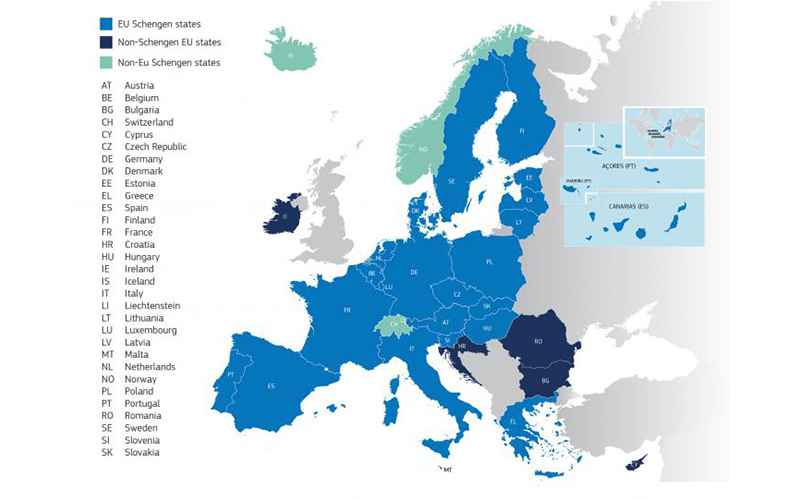If you are planning to visit Europe, the first thing you must ask yourself is whether you need a Schengen visa. Currently, nationals of over 60 countries can enter the visa-free zone in Europe without obtaining a visa and stay for up to 90 days within a 180-period.
But if you want freedom of movement in this area, you must apply for a European visa. You should be extremely careful when applying for a Schengen visa. So in the next section of the article, we have added a Schengen Visa Guide.
What is the Schengen area?
The Schengen Area is a zone where neighboring European countries have eliminated passport controls, restrictions on the movement of people, and other border control regulations at their mutual borders. Simply put, there are no hard borders between these neighboring countries. There is only one shared border. The Schengen agreement was developed to control external border, promote harmony and friendship, and strengthen relationships between neighboring countries and a common judicial system.
Currently, 29 European countries are part of the Schengen agreement, with Bulgaria and Romania joining as the latest members on January 1, 2025.
Schengen Agreement
The Schengen area covers most of Europe, including some of the continent’s most powerful and oldest countries. It is one of the significant achievements of the European project. Schengen is the name of a small village in Luxembourg on the border of Germany and France, where the Schengen Convention was signed in 1985 and 1990, respectively.
France and Germany were the first to join the Schengen agreement, as the countries took the initial step towards creating a visa-free and passport-free zone on June 14, 1984.
The governments of Germany, France, Luxembourg, Belgium, and the Netherlands joined the Schengen Agreement on June 14, 1985, and under this agreement, the five countries would gradually abolish border checks at their common borders. The Schengen area was expanded a few months later, with Italy signing the agreement first, followed by Spain and Portugal.
Famous Countries that Belong to the Schengen Area
Image Credit: home-affairs.ec.europa.eu
The Schengen area has 29 countries, covering almost all of Europe. Some of the popular countries that are part of the treaty are:
1. Austria
Austria, located in central Europe, is bordered by eight countries. It is one of the richest countries in the world, with per capita income and GDP. It signed the Schengen agreement in 1995 but implemented it more than two years later, on December 1, 1997.
 Featured
Featured  Featured
Featured 2. Belgium
Belgium, in Western Europe, was among the first five countries to join the Schengen agreement on June 14, 1985, and it implemented it on March 26, 1995. It is located in Western Europe, and its capital, Brussels, is the European Union’s administrative center, often referred to as the EU’s capital city.
3. Croatia
 Located in Central and Southeast Europe, Croatia is known for its gorgeous coastline and other popular tourist attractions, including its rich cultural heritage, ancient ruins, and churches. The country joined the Schengen agreement recently, on January 1, 2023. It is a member of the European Union and the Council of Europe.
Located in Central and Southeast Europe, Croatia is known for its gorgeous coastline and other popular tourist attractions, including its rich cultural heritage, ancient ruins, and churches. The country joined the Schengen agreement recently, on January 1, 2023. It is a member of the European Union and the Council of Europe.
4. Germany
The second-most-visited Schengen country, Germany, is the land of invention and innovation that travellers would love to explore. It is situated in Western and Central Europe and is one of the five founding countries of the Schengen Agreement, signed on June 14, 1985. However, it implemented the agreement ten years later, on March 26, 1995.
 Featured
Featured 5. Greece
One of the most famous destinations and the cradle of Western civilization, Greece is considered the birthplace of democracy, western literature, historiography, the Olympic Games, and more. The country has a unique cultural heritage. It signed the agreement on November 6, 1992, and began implementing it on January 1, 2000.
 Featured
Featured 6. Hungary
Hungary is in Central Europe, drawing a high number of visitors every year. When it comes to tourism, Hungary is one of the main medical tourist destinations in Europe. It signed the Schengen agreement on April 16, 2003, and implemented it on December 21, 2007.
7. Italy
The sovereign state of the Italian Republic, located in the heart of the Mediterranean Sea, offers a rich history and numerous cultural attractions, making it one of Europe’s top destinations. It implemented the Schengen Agreement on October 26, 1997, after it was signed on November 27, 1990.
 Featured
Featured  Featured
Featured 8. Latvia
Sharing borders with Estonia, Lithuania, and Belarus to the southeast, Latvia is currently a member of the European Union, NATO, the Council of Europe, the United Nations, CBSS, the IMF, NB8, NIB, OECD, OSCE, and WTO. It signed the agreement on April 16, 2003, and implemented it on December 21, 2007.
9. Lithuania
Lithuania signed the Schengen Agreement on April 16, 2003, and began implementing it on December 21, 2007. Lithuanian is one of the oldest languages in the world.
10. Luxembourg
Luxembourg is the second-richest country in the world, ranked by its GDP, and also has the highest minimum wage in the EU. It signed the agreement on June 14, 1985, and it is one of the three official capitals of the European Union.
11. Malta
Mostly known for its sun, sea, and beaches, Malta is one of the most alluring destinations in Europe. It signed the agreement on April 16, 2003, and implemented it on December 21, 2007.
12. Netherlands
With its colorful tulips, delicious cheese, and windmills, the Netherlands is one of the founding members of the EU, the Eurozone, the G10, NATO, the OECD, the WTO, and the Schengen Agreement, signed on June 14, 1985.
13. Poland
As an EU country, Poland attracts visitors to its most visited cities, such as Malbork, Torun, Krakow, and Poznan. The country signed the agreement on April 16, 2003, and implemented it in late 2007.
14. Spain
Spain draws visitors from around the world to explore its famous cities, such as Madrid and Barcelona. The country joined the agreement on June 25, 1991, and it was implemented on March 26, 1995.
 Featured
Featured  Featured
Featured 15. Slovakia
Slovakia is known for having the world’s highest number of castles and chateaux per capita. It signed the agreement on January 1, 1993, and started the implementation on December 21, 2007.
16. Slovenia
Slovenia is one of the smallest Schengen states. The country signed the agreement on April 16, 2003, and started it four years later, on December 21, 2007.
17. Sweden
Sweden, located in northern Europe, is a Scandinavian country that signed the agreement on December 9, 1996. It started its implementation on March 25, 2001.
Among the list, Germany, Luxembourg, Belgium, France, and the Netherlands were among the first countries to join the Schengen area.
However, you must understand that the Schengen area and the European Union (EU) are two different entities. The Schengen area spans 4 million square kilometers and has a population of almost 420 million people.
Being part of the Schengen area without internal border control means that:
- There are no internal checkpoints in the area. Secure external borders ensure the region’s safety.
- The countries that signed the agreement must adhere to border protocols outlined in the Schengen Borders Code.
- If you are entering the area from a third country, you need an ETIAS visa waiver or a Schengen visa. These two are entirely different types of travel documents, each of which allows you to stay in Schengen for a maximum of 90 days.
- A visit to one of the Schengen countries is undoubtedly worthwhile, offering numerous activities and a rich heritage to explore. As a Dubai resident, if you are wondering how to apply for a Schengen visa from Dubai, below is a brief overview of the visa application process.
A visit to one of the Schengen countries is undoubtedly worthwhile, offering numerous activities and a rich heritage to explore. As a Dubai resident, if you are wondering how to apply for a Schengen visa from Dubai, below is a brief overview of the visa application process.

Schengen Visa
Easy Documentation
Online Payment Option
How will you apply for a Schengen visa if you are a Dubai resident?
Even though Dubai, the capital of the emirates, is one of the most popular tourist locations in the world, as a Dubai resident, you must apply for a Schengen visa to visit the area. Let us briefly discuss the procedure and how to apply for a visa in Dubai.
Schengen Visa
It is a limited-stay visa that allows you to visit any Schengen country and stay for up to 90 days for business or pleasure.
Can you apply for a Schengen visa in the UAE?
If you are a UAE passport holder, you can enter any Schengen country and stay for 90 days, visa-free for 180 days. If you live in one of the seven emirates and do not have a UAE passport, you must get a Schengen visa depending on your nationality.
You can only apply if you belong to one of the following categories:
- A foreigner living in the UAE on a temporary or permanent residence permit
- A UAE passport holder who was previously refused visa-free entry to a Schengen country
- A national of a country that has a mutual agreement on a visa-free regime with the Schengen area, but has refused visa-free entry to Europe
The Schengen visa guide to getting a Schengen visa in the UAE
Here’s how to apply for a Schengen visa from Dubai:
- Check with the embassy or consulate where you need to submit the application.
- Schedule an appointment at the visa center or embassy.
- Attend the visa interview with all the essential documents.
- Wait for a response.
You have to wait for a minimum of 15 days, after which you will get the responsible application.
Schengen Visa Document Requirements
- The visa application form must contain accurate, error-free information.
- A valid passport that should not be less than ten years old and has a validity of at least three months beyond the date when you plan to leave the zone.
- Two photographs that were not taken more than three months before you plan to apply for your visa; they must adhere to the visa photo requirements.
- Travel flight itinerary, which proves that you have reserved a flight ticket from Dubai to the Schengen area and back
- Travel insurance for Europe with a minimum coverage of 30000 euros
- Proof of residency in the UAE, a document demonstrating that you have the required residence permit that is valid for at least three months after your intended departure date from a Schengen country
- Proof of accommodation, a document stating where you will be staying in Schengen
- Proof of financial means, like a bank account statement, a sponsorship letter, or a combination of both
- Proof of paid visa application fees
- A cover letter explaining the purpose of the visit
Charges for a Schengen Visa
To apply for the visa, you must pay a non-refundable application fee, which is mandatory for all applications.
- Adults: 1000 AED
- Children under the age of six: free
- Member of EU / EEA National: free
- Diplomatic and service passport holders: free
Where do I apply for a Schengen visa in the UAE?
To apply for your Schengen visa from Dubai, we have a dedicated team at Rayna Tours and Travels to help you with your Schengen visa procedures, starting from choosing the right visa to its document compilation, processing, and approval.
You have to be careful while submitting your application. Ensure your visa application is lodged at the correct time, as it will be immediately rejected if you lodge at the wrong place.
Schengen visas might often get rejected due to spelling errors or mistakes during the interview. So, always take precautions or seek expert assistance to avoid such inconveniences. However, if it is rejected, you can always apply again or appeal the decision by writing a letter to the Schengen visa office.
FAQS









